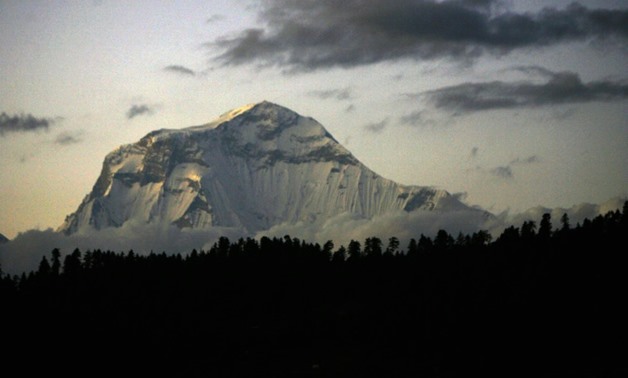
Mount Gurja lies next to the avalanche prone Dhaulagiri range
AFP / PRAKASH MATHEMA
Nine members of a South Korean climbing expedition were killed after a violent snowstorm swept them off a cliff on Nepal's Mount Gurja, one of the deadliest mountaineering accidents to hit the Himalayan nation in recent years.
The bodies of eight climbers -- four South Koreans and four Nepali guides -- were spotted near the wreckage of their camp by a rescue team Saturday morning, but strong winds were hampering the search effort.
A fifth South Korean climber was initially reported missing, but officials later confirmed he was at the camp when the deadly storm hit Friday and also perished.
"A mountain expedition of five South Korean nationals and four foreigners were swept off by strong winds at the base camp during their climb to Mount Gurja. (They) fell off a cliff and died," the South Korean foreign ministry said in a statement.
Helicopter pilot Siddartha Gurung was among the first people to reach the site after the deadly storm and described a scene of total destruction.
He said all the tents had been flattened, reduced to a tangled mess of tarpaulin and broken polls, and the climbers' bodies were scattered across a wide area, including some in a river bed some 500 metres (1,640 feet) away from the main camp.
"Everything is gone, all the tents are blown apart," Gurung told AFP.
Gurung landed a helicopter just above the expedition team's camp and attempted to descend to the campsite with a group of local villagers, but icy and unstable conditions meant they were unable to retrieve any of the bodies.
Rescue officials tried to send a second helicopter to the site but it was unable to fly due to strong winds, police spokesman Sailesh Thapa told AFP.
Another attempt will be made Sunday, he added.
- Deadliest incident -
The storm is the deadliest incident to hit Nepal's mountaineering industry since 18 people were killed at Mount Everest's base camp in 2015 in an avalanche triggered by a powerful earthquake.
The previous year, 16 Sherpas were killed on Everest when an avalanche swept through the Khumbu Icefall during the busy Spring climbing season. Then in October, a freak blizzard killed more than 40 tourists and their guides in the Annapurna region, a disaster that was largely blamed on poor weather forecasting and lacklustre safety standards in Nepal's poorly regulated trekking industry.
Mountain weather is known for being unpredictable with strong winds capable of throwing a person off balance.
In April, an Italian climber died after he was blown off Mount Dhaulagiri, the world's seventh highest peak which neighbours Mount Gurja. But the Italian was at 6,900 metres when his tent was swept off the mountain, whereas the South Korean team were below 4,000 metres when they were hit by powerful winds.
"The fact that they were so low when it happened is unusual," said experienced German climber Billi Bierling, who was forced to call off her own summit bid on Dhaulagiri last month because of heavy snowfall and high winds.
The South Korean team had been on 7,193-metre (23,599-foot) Mount Gurja since early October, waiting for a window of good weather so they could attempt to reach the summit.
Feted South Korean climber Kim Chang-ho, who in 2013 became the fastest person to summit the world's 14 highest mountains without using supplemental oxygen, was leading the expedition, according to a government-issued climbing permit seen by AFP.
The permit listed four South Korean climbers, but a fifth member had joined the team later, according to Suresh Dakal of Trekking Camp Nepal, the expedition organiser.
A sixth South Korean national was staying in a village in the valley below the mountain when the powerful storm struck and survived, according to a local police report.
Rarely-climbed Gurja was first summited in 1969 by a Japanese team but no one has stood on its summit for 22 years, according to the Himalayan Database.
The South Korean team were planning to scale the mountain via a never-climbed route, the Korean Alpine Federation said.
Four climbers have previously perished on Gurja's flanks and a total of 30 have successfully reached its peak -- a fraction of the more than 8,000 people who have summited Everest, the world's highest mountain.
Thousands of climbers flock to Nepal each year -- home to eight of the world's 14 highest peaks -- creating a lucrative mountain tourism industry that is a vital source of cash for the impoverished country.

Comments
Leave a Comment